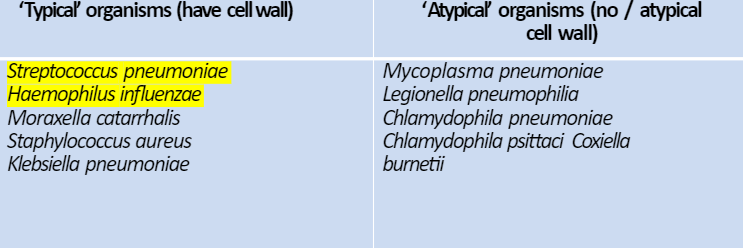An acute lower respiratory tract infection associated with fever and other abnormal chest symptoms and signs
Bacterial
- Usually rapid onset
- Productive cough
- SOB
- Fatigue, anorexia, myalgia, fever
- Dull to percuss with reduced air entry
Viral
Causes/Factors
-
Community acquired (CAP) - most common streptococcus pneumoniae. Occurring outside of hospital or within 48hr of admission
-
Haemophilus influenzae - common in older patients with COPD
-
Klebsiella pneumonia - more common in diabetics and patients with alcohol excess. Frequently caused by aspiration. Can cause “red jelly”. Commonly affects upper lobes
-
Staphylococcus aureus pneumonia commonly occurs after influenza or as a complication of measles infection. CXR shows multi-lobar consolidation, cavitation or pneumothorax
-
Mycoplasma is a typical which classically presents with a gradual onset dry cough and other weird symptoms - autoimmune haemolytic anaemia and erythema multiforme

CURB-65 - one point for each
- Confusion - AMTS 8
- Urea - >7 mmol/L
- RR - 30
- Blood pressure < 90 systolic or <60 diastolic
- Age 65 (soft score)
0-1 - low risk home management - 500mg amoxicillin TDS for 5 days 2 - intermediate risk - short in-patient stay 3 - high risk - severe pneumonia
Risk of death with CURB-65
| Score | Risk of death at 30 days |
|---|---|
| 0 | 0.7% |
| 1 | 3.2% |
| 2 | 13.0% |
| 3 | 17.0% |
| 4 | 41.5% |
| 5 | 57.0% |
-
Hospital acquired (HAP) - after 48hs from admission
-
Ventilator associated (VAP)
-
Asp iration Pneumonia
-
Immunocompromised patient - patients recurrently coming with a CAP is an indicator of HIV - esp if organism is weird
Symptoms
- Fever
- Rigors
- Anorexia
- Dyspnoea
- Productive cough
- Pleural pain
Signs
- Pyrexia
- Cyanosis
- Confusion - may be only sign in elderly patients
- Tachypnoea
- Tachycardia
- Hypotension
- Hypoxia
- Bronchial breathing (harsh breath sounds) and crackles heard
Diagnostic Tests
-
CXR: showing consolidation
-
Blood/sputum culture
-
Bronchoscopy if risk of infection for bloods
-
U&Es - hyponatremia Pneumonia legionella. Can also use urinary antigen very sensitive and specific for legionella
-
Pet history - parrots Chlymidia pneumonitis
-
Weird rash Mycoplasma
Management
ABCDE
- Fluids
- Oxygen
- Antibiotics
- Assisted ventilation
Complications/red Flags
- Type 1 Respiratory Failure ()
- Hypotension ← vasodilation/dehydration ← Sepsis
- Atrial Fibrillation - common in elderly, usually resolves with treatment
- Pleural Effusion - inflammation of pleura leading to fluid build up
- Empyema - pus in pleural space, should be drained with chest drain
- Lung Abscess
- Pericarditis and myocarditis
- Jaundice - usually cholestatic - may be due to Sepsis or secondary to antibiotic treatment (esp. flucloxacillin and Co-amoxiclav)